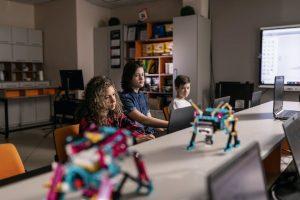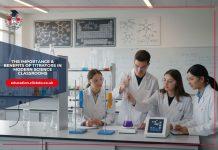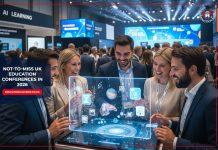Education has always been dynamic, constantly adapting to new methods and technologies. With the advent of digital tools, classrooms are experiencing a significant shift.
Teachers are moving from traditional lecture-based methods to more interactive and engaging practices. This tech transformation is not just a trend; it’s a response to the changing needs of students growing up in a digitally interconnected world.
Interactive learning tools are at the forefront of this educational evolution, offering varied and innovative ways to enhance teaching and learning experiences. As educators, embracing these changes is crucial for keeping pace with the evolving educational environment.
This article explores the variety of interactive tools available and their benefits in the classroom. It will guide you through integrating these tools into your teaching strategy, enhancing learning, lesson presentation, and overcoming potential challenges.
Interactive Learning Tools Helping Transform Education

Interactive learning tools have revolutionized the way educators approach teaching. These tools provide a more hands-on, collaborative, and immersive learning experience. By incorporating technology like interactive whiteboards, student response systems, and simulation software, lessons become more engaging and stimulating for students.
Educators should first assess their teaching objectives and the needs of their students when selecting the appropriate tools. A good starting point is to explore various software and platforms that offer interactive features. Teachers can then gradually incorporate these tools into their lessons, ensuring they complement and enhance the learning objectives.
It’s about balancing technology and traditional teaching methods to create a holistic and effective learning environment.
The Benefits Of Interactive Learning In Education
The integration of interactive tools in education brings a host of benefits. Firstly, these tools significantly boost student engagement. When students actively participate in their learning process through interactive elements, they are more likely to maintain focus and interest. This heightened engagement leads to better retention of information, as interactive methods often make learning more memorable.
Moreover, interactive tools cater to various learning styles. Whether a student is a visual learner, an auditory learner, or a kinesthetic learner, interactive technologies offer diverse methods of presenting information. Educators should aim to use these tools to present lessons in multiple formats – using videos, interactive tasks, and group activities – to ensure all students benefit regardless of their preferred learning style.
Additionally, these tools encourage creativity and critical thinking. Educators can foster a higher level of cognitive engagement by presenting students with interactive challenges and problem-solving scenarios. It’s essential to create opportunities within lessons where students can use these tools to explore, create, and apply knowledge in innovative ways.
Types Of Interactive Learning Tools

Educators will find various technologies when delving into interactive learning tools. Tools like interactive whiteboards allow for dynamic, real-time presentations to which teachers and students can contribute. Student response systems enable immediate feedback during lessons, helping educators gauge understanding and adjust their teaching accordingly.
Another category is simulation software, which provides students with realistic scenarios where they can apply theoretical knowledge. This hands-on approach is particularly effective in subjects like science and engineering. Furthermore, educational games can make learning fun and engaging, especially for younger students, promoting learning through play.
Educators need to carefully select the tools that best fit their curriculum and teaching style. It’s about enhancing the learning experience without overwhelming students with technology. Trial sessions and student feedback can be invaluable in determining the effectiveness of different tools in enhancing learning.
Enhancing Lesson Presentation With Interactive Tools
Effective lesson presentation is a key component of successful teaching, and interactive tools can significantly enhance this aspect. Integrating multimedia elements such as videos, animations, and interactive diagrams allows educators to make complex concepts more understandable and engaging. This visual and interactive approach meets the diverse learning preferences of students, making content more accessible.
In interactive tools, platforms like Issuu to create Canva flipbooks offer a novel way to present lessons. These flipbooks can transform traditional text-based materials into interactive, visually appealing formats. They are particularly useful for creating dynamic presentations and easily shareable revision resources. The flipbook format allows educators to incorporate various multimedia elements, making lessons more interactive and engaging for students.
Educators should set clear objectives when planning lessons to use these tools effectively. Incorporating interactive elements needs to be purposeful and relevant to the subject matter. For example, an interactive timeline in a history lesson can vividly illustrate a series of events, while interactive quizzes in science can solidify understanding of key concepts.
It’s important to ensure that these interactive elements enhance the lesson rather than overshadow it. Maintaining various interactive content in presentations is crucial to keeping lessons fresh and engaging.
Integrating Interactive Tools Into Your Teaching Strategy

Integrating interactive tools into teaching strategies requires thoughtful planning and flexibility. Educators should identify areas of their curriculum that could benefit most from interactive enhancement. For instance, students typically find challenging or unengaging topics excellent candidates for introducing interactive elements.
Training and familiarity with chosen tools are essential. Educators should take time to understand each tool’s functionalities and potential applications. This preparation ensures that technology enhances rather than disrupts the learning process. Collaborating with fellow educators can provide valuable insights and ideas on effective integration methods.
It’s important to be responsive to student feedback. Regularly seeking input from students on the effectiveness of the tools can guide educators in fine-tuning their approach. This feedback loop ensures that technology integration remains focused on improving educational outcomes.
Overcoming Challenges With These Tips For A Smooth Transition
Adopting new technologies in the classroom is not without its challenges. One of the primary hurdles is resource limitation. Not all schools have the budget for state-of-the-art interactive tools. Educators can focus on cost-effective solutions like free online resources or interactive apps.
Another challenge is the learning curve associated with new technology. Educators should approach this gradually, starting with simpler tools and progressing to more advanced ones as they become more comfortable. Professional development workshops and online tutorials can be invaluable in this learning process. Sharing experiences and tips with colleagues navigating similar challenges is also beneficial.
Finally, it’s crucial to consider the diverse technological proficiency of students. Some may adapt quickly to new tools, while others need more guidance. Ensuring that lessons are inclusive and accessible to all students is essential. Educators can achieve this by providing clear instructions, offering additional support, and creating a classroom environment where students feel comfortable asking for help.
Measuring The Impact With Feedback And Adaptation

How do you ensure the effective use of interactive learning tools? Measure their impact through feedback mechanisms such as student surveys, assessments, and direct observation. Feedback helps educators understand what’s working and what’s not, allowing them to make informed adjustments.
Adaptation is a continuous process. Educators should be prepared to tweak their teaching methods based on feedback. This might involve trying different tools, adjusting their frequency, or changing how they are integrated into lessons. Keeping abreast of new developments in educational technology can also provide fresh ideas and approaches to enrich the learning experience.
It’s equally important to celebrate successes. When a particular tool or method proves effective, sharing this experience within the educational community can inspire others and contribute to a collective pool of knowledge and best practices.
Embracing The Future Of Education
As we navigate the evolving education landscape, the importance of integrating interactive learning tools becomes increasingly clear. These tools are about keeping up with technological trends and enriching the educational experience for teachers and students. They offer a pathway to make learning more engaging, inclusive, and effective.
The goal is to prepare students for a world where digital literacy is integral. By embracing interactive educational tools, educators enhance their teaching methods and equip students with the skills they need to succeed in a digitally interconnected world.
Author Profile

- Editor in Chief
- Blogger and Educator by Passion | Senior Online Media & PR Strategist at ClickDo Ltd. | Contributor to many Education, Business & Lifestyle Blogs in the United Kingdom & Germany | Summer Course Student at the London School of Journalism and Course Instructor at the SeekaHost University.
Latest entries
 Directory PostsOctober 29, 20257 Not-To-Miss UK Education Conferences in 2026
Directory PostsOctober 29, 20257 Not-To-Miss UK Education Conferences in 2026 Directory PostsOctober 16, 2025The 12 Best Online Tutoring Platforms in the UK
Directory PostsOctober 16, 2025The 12 Best Online Tutoring Platforms in the UK Directory PostsOctober 6, 2025Top 12 London Private Schools – Best Independent Schools Nearby
Directory PostsOctober 6, 2025Top 12 London Private Schools – Best Independent Schools Nearby careerSeptember 10, 20258 Top Online Future Career Courses To Know
careerSeptember 10, 20258 Top Online Future Career Courses To Know





